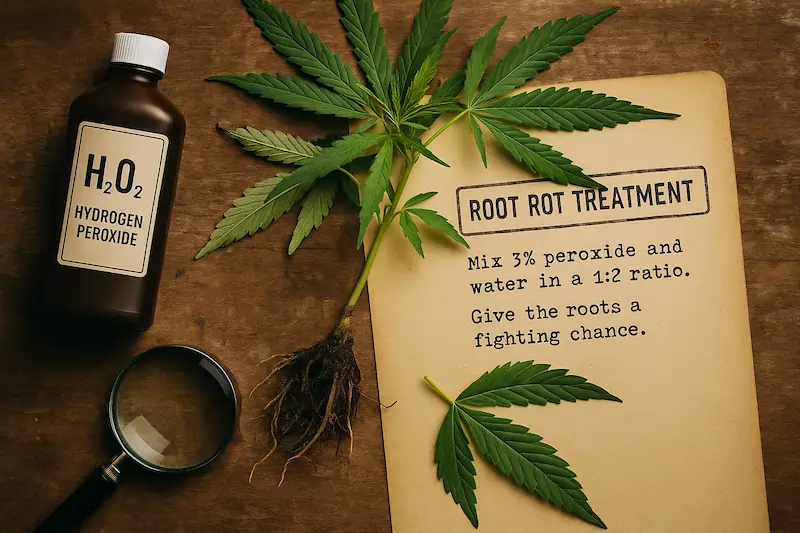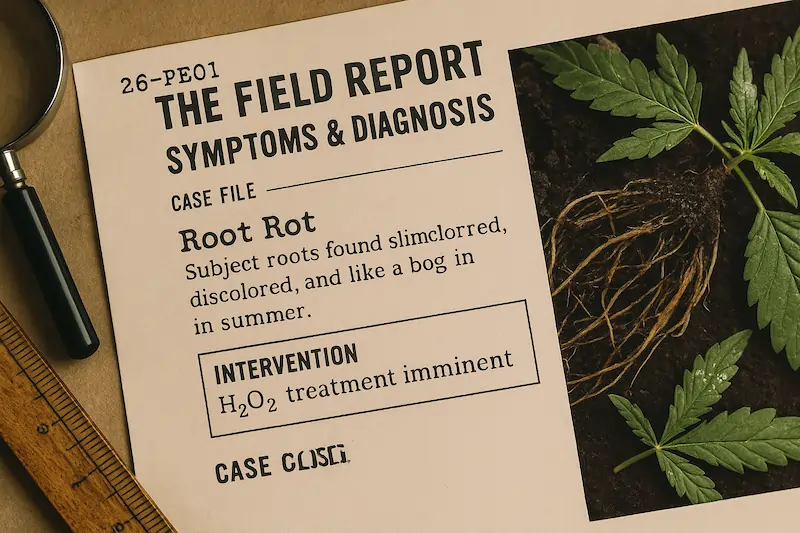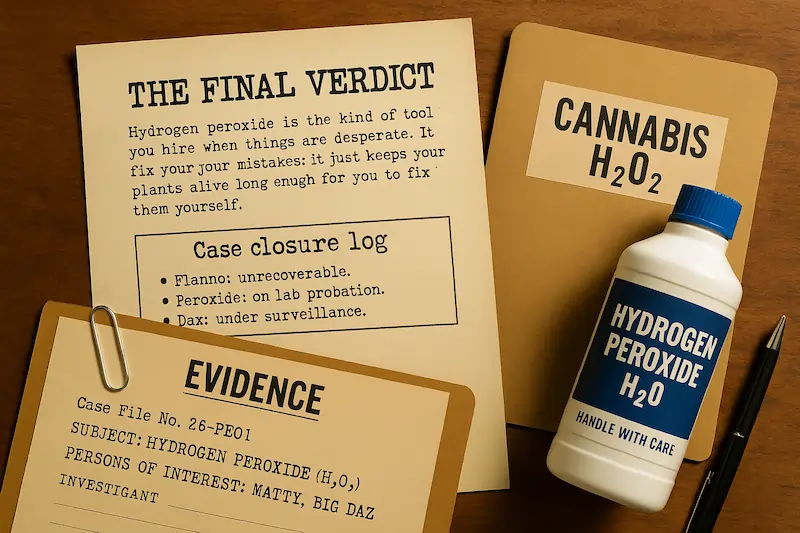Case File No. 26-PE01
Subject: Hydrogen Peroxide (H₂O₂)
Persons of Interest: Matty, Big Daz
Investigating Officer: Matty Ridge
Experiment 7B — Peroxide Incident Log
14:02 — Dose prepared. 14:05 — Tent begins to hiss like a kettle. 14:06 — White froth surges from the bucket; one (1) favourite flanno develops a ventilation feature. Conclusion: peroxide is a beast that does not forgive sloppy hands.
To most, hydrogen peroxide is a first-aid spray. To a certified madman like me, it’s a powerful tool with one crucial rule: respect the bubbles, or they will turn on you.

Observation Log: Chemical Behaviour
In the bottle, H₂O₂ is a quiet overachiever. Touch a living surface and catalase flips the switch, splitting the molecule and blasting out oxygen:
2 H2O2 —(catalase)→ O2 + 2 H2O
Think of it like a tiny, invisible defibrillator shocking roots back to life. Used right, it’s glorious. Used wrong, it’s a pet crocodile in a paddling pool.
The Field Report: Symptoms & Diagnosis
Classified notes from the grow room — each case treated like a crime scene.
- Root Rot: Roots slimy, discoloured, boggy odour. Peroxide won’t resurrect dead tissue, but it will knock back pathogens and buy time for new growth.
- Fungal Leaf Spots / Powdery Mildew: White fuzz colonies advancing. Deploy a mild foliar spritz and fix airflow fast.
- Algae in Hydro: Green insurgents clogging lines. Flush with diluted H₂O₂; restore light-proofing and sanitation.
- Pest Pressure: (REDACTED: “tiny flying demons”). Gentle contact spray can disrupt eggs/pathogens while you overhaul hygiene.

Handling the Volatile Concoction: Proportionality Protocols
All ratios assume 3% H2O2. Gloves on, ego off.
- Root Rot (acute, capillary method):
Dry the medium until it’s thirsty as a camel. Place the pot in a tray and bottom-feed at 30–50 ml/L. Let roots sip the active peroxide directly — this gets oxygen into the tight clusters where rot hides. Repeat every 3–4 days max, then stop. Rebuild biology after. - Oxygenating Soil/Media (preventative flush):
10–15 ml/L as a light top-water once every 7–10 days. Enough to freshen the zone without torching the microbiome. - Sterilising Tools & Surfaces:
10 ml/L soak or wipe. Not for skin (unless “bleached coral” is your aesthetic). - Foliar Mist (spot mildew/fungal leaf issue):
1–2 ml/L. Only for small, patchy outbreaks. Spray one leaf as a test; abort if it “screams.” - Hydro/Reservoir Flush:
3 ml/L to knock algae back. Run for ~24 hours, then drain and re-inoculate with beneficials.
| Use Case | 3% H2O2 Rate | Method | Frequency |
|---|---|---|---|
| Root rot (acute) | 30–50 ml/L | Bottom-feed (capillary) | Every 3–4 days, short course |
| Oxygenate media (prevent) | 10–15 ml/L | Light top-water | Every 7–10 days |
| Tools & surfaces | 10 ml/L | Soak / wipe | As needed |
| Foliar spot (mildew) | 1–2 ml/L | Mild mist, patch test | Short course only |
| Hydro reservoir flush | 3 ml/L | Circulate ~24h, drain | As needed |
Matty’s Advanced Lab Notes
- Top vs Bottom Delivery: Watering peroxide from the top? You’re basically giving your roots Evian with bubbles. H2O2 is too reactive — it’s gone before it reaches the infection. Bottom-feed so the roots actually sip the good stuff.
- pH Protocol: Peroxide can nudge pH down. Re-check after dosing or your roots will sulk like teens with no Wi-Fi.
- Preventative vs Curative: Light, infrequent = preventative. Heavy, targeted = curative. Never run curative strength “just in case.” Ask Big Daz why.
- Germination Assist (stubborn seeds): 1.5 ml/gal (0.4 ml/L) soak for up to 12 hours. Oxygen bath for reluctant seeds. Do not add heaters and bravado.
Matty’s Hulk-Out Warnings
- Do not pour peroxide into a humidifier. “Chemical spa day” is not a vibe.
- Do not hand H2O2 to Big Daz unsupervised. He once mistook it for contact lens solution.
- Do not combine H2O2, molasses, and a DIY CO2 bucket. My ceiling still smells like burnt fairy floss.
Case Closure Log
- Reservoir: stabilised. pH: corrected.
- Beneficials: reintroduced (mycorrhizae/compost tea) after peroxide course.
- Peroxide: on lab probation.
- Daz: banned from the cupboard with the brown bottles.
- Flanno: unrecoverable.

Final verdict: H₂O₂ won’t add grams by itself; it just keeps plants alive long enough for you to fix the real problem. Use sparingly, store cool and dark, gloves on, ego off.
Case File Teaser
Next on the Ridgey-Didge desk: a strain so elusive it may be under witness protection. The White Widow Witness Protection Program.
Filed and signed,
Officer Ridge — Dept. of Bud & Order
 AUS Stock - Local Delivery
AUS Stock - Local Delivery